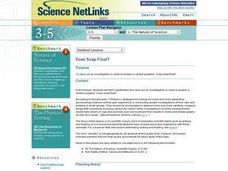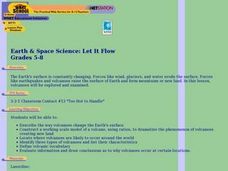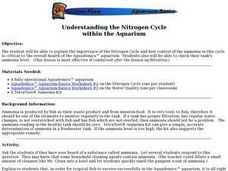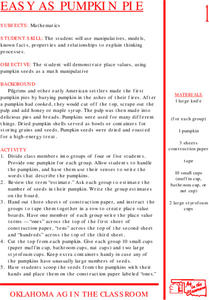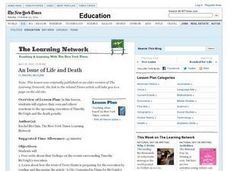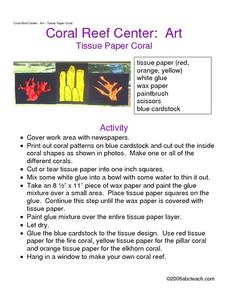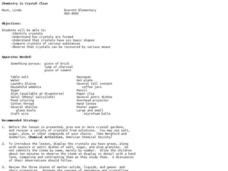Curated OER
GUITARS AS SCULPTURE
Students discuss guitars, pointing out different parts of the guitar, compare/contrast guitars from different times, imagine they are designers hired to build a new age guitar, create many preliminary sketches, choose one, and begin...
Curated OER
Does Soap Float?
Students form hypotheses and carry out an investigation in order to answer a central question: Does soap float? The focus of this lesson is on scientific inquiry, but it incorporates scientific topics such as sinking and floating.
Curated OER
Miss Tizzy
Students experience ways language and visuals bring characters to life in a story, experience age-appropriate songs, cooking experiences, and art, learn the days of the week in a new learning experience, and engage in hands-on learning...
Curated OER
Earth and Space Science: Let it Flow
Students engage in a lesson in which volcanoes be explored and examined. After watching a video, students create volcanoes out of clay.
Curated OER
Magnets: They Are Totally Attractive
Students classify objects that magnets are attracted to and aren't attracted to. They also magnetize metal. They construct and use a compass. They develop a product which show they explain the properties of magnetism.
Curated OER
Landforms: Geomorphology of Arkansas
Second graders create large, salt dough maps of Arkansas and the natural regions in the state created by geographical and morphological features.
Curated OER
Can You Dig It?
Learners use a mock archaeological site to dig up artifacts. They read an article about artifacts found in Syria. They develop a list of artifacts that are related to specific sites in the community. They create an exhibition of these...
Curated OER
Understanding the Nitrogen Cycle within the Aquarium
Students discuss ammonia, and ways it may get into the aquarium. They complete a worksheet about the Nitrogen Cycle. Students learn how to get the ammonia and nitrite out of their aquarium.
Curated OER
Bacterial growth
Students explore the exponential growth and decay of microbial populations in relation to the organism tolerance ranges in their environment, They observe the impact of changing variables which can affect microbial populations.
Curated OER
Japan: Traditions and Culture
Fourth graders explore Japanese customs and history. They create their own works that reflect these traditions. They identify and use primary and secondary sources to learn and communicate about the past.
Curated OER
EASY AS PUMPKIN PIE
Students demonstrate place values using pumpkin seeds as a math manipulative. They use manipulatives, models, known facts, properties and relationships to explain thinking processes. They estimate the number of seeds in their pumpkin.
Curated OER
An Issue of Life and Death
Learners explore the reaction to the execution of Timothy McVeigh. They discuss the event, interview others concerning the death penalty, and write an article on reactions to the execution of Timothy McVeigh.
Curated OER
Minerals Make Rocks
Young scholars examine that all rocks are made from one or more minerals (or plant material, as in the case of coal). They make mock rocks and discuss the difference between a rock and a mineral.
Mathematics TEKS Toolkit
Grade 6: Exploring c/d = pi
Introduce your math class to the perimeter of a circle. Teach them that pi describes the relationship between the circumference and the diameter. As a hands-on investigation, pairs or small groups use string to compare these two values...
Curated OER
Cooking With Cuisinaires
Second graders explore fraction with Cuisenaire Rods. In this fraction lesson, 2nd graders recieve "recipe" cards for adding fractions. After practicing, students create their own cards then exchange with each other to...
Curated OER
Discovering the Properties of Matter
Students identify the properties of the three states of matter and observe the movement of Oobleck and be able to compare its movement to that of solids and liquids. They record in their Science Journal what they discovered about Oobleck.
Curated OER
What Caused the Great Depression?
Analyze the many causes of major political, economic, and social developments during the 1920s and 1930s, with emphasis on the Great Depression. Read photographs from the 1920's and the 1930's, then write a brief explanation of what you...
Curated OER
Gotta Dance
Students share dance moves that reflect their personalities or depict how they are feeling, explore popularity of recreational and competitive social dancing by reading and discussing the article "Follow the Flying Feet,"
present...
Curated OER
Coral Reef : Art Tissue Paper Coral
In this coral reef art worksheet, students follow directions to complete a piece of art. Students use cardstock, tissue paper, and wax paper to make a beautiful picture.
Curated OER
White House Facts
In this ESL handwriting skills worksheet, students trace four facts, in cursive handwriting, about the White House located in Washington D.C.
Curated OER
How Pollution Disrupts Our Natural Environment
Students conduct experiments to illustrate global warming. In this air pollution lesson, students first examine how a layer of greenhouse gasses might impact the earth's atmospheric temperature, then evaluate how the layer of gasses...
Curated OER
Recycling
Third graders observe the importance of recycling. In this environmental lesson, 3rd graders will view experiments on water filtration, paper-making, and breathing pollutants, and will categorize recyclable materials.
Curated OER
Chemistry is Crystal Clear
Students observe crystals and their shapes and formation. In this crystal formation lesson plan, the teacher prepares crystal gardens for the students to observe, then the class finds examples of crystals in nature and observe a teacher...
Curated OER
Watching the Elections
Learners analyze the media products and advertising techniques used in political campaigns. In this elections lesson, students view political debates and then work in groups to find examples of types of advertising techniques used in...



